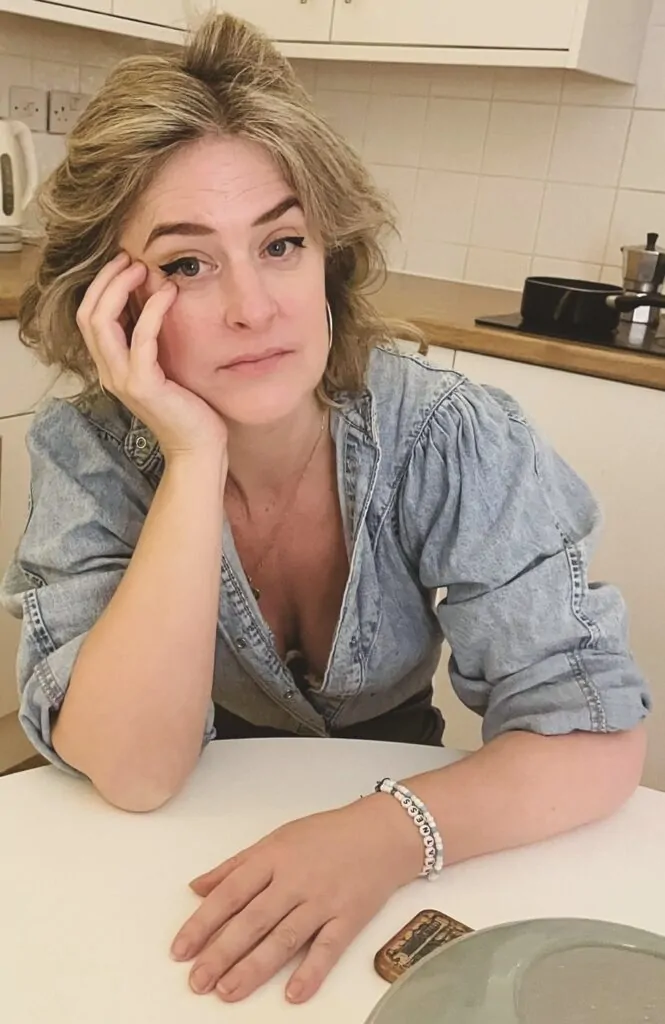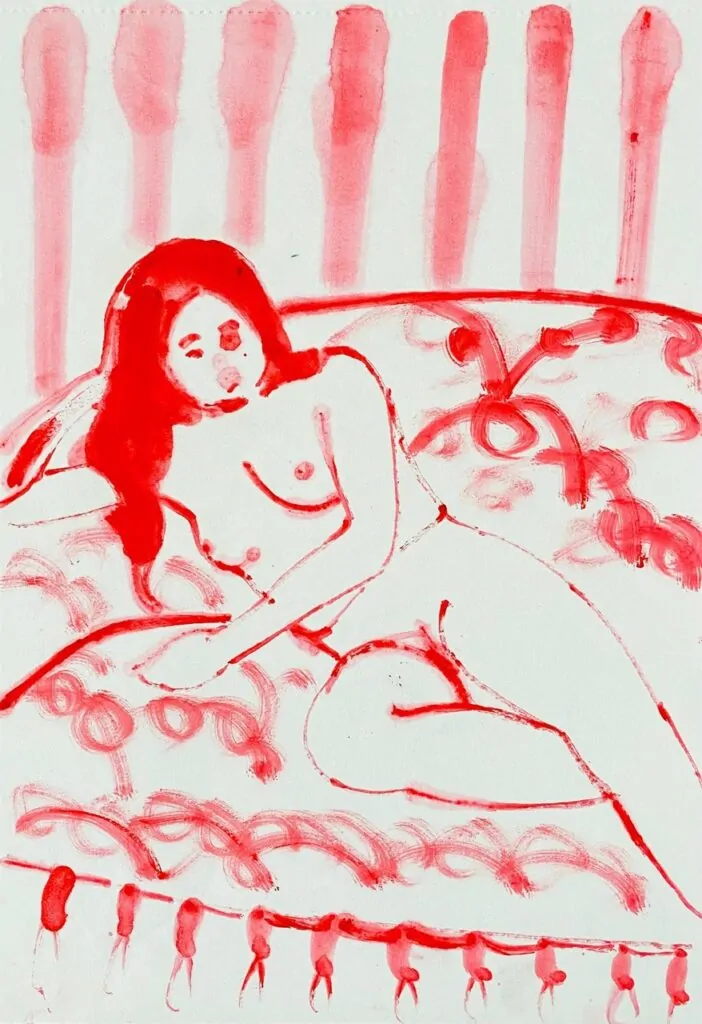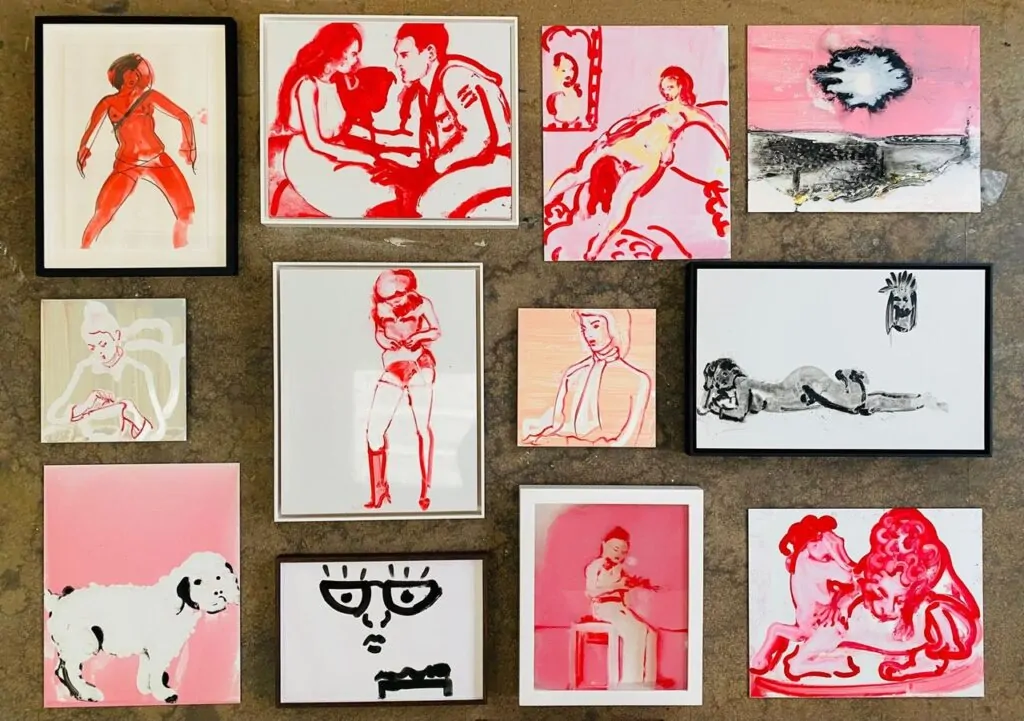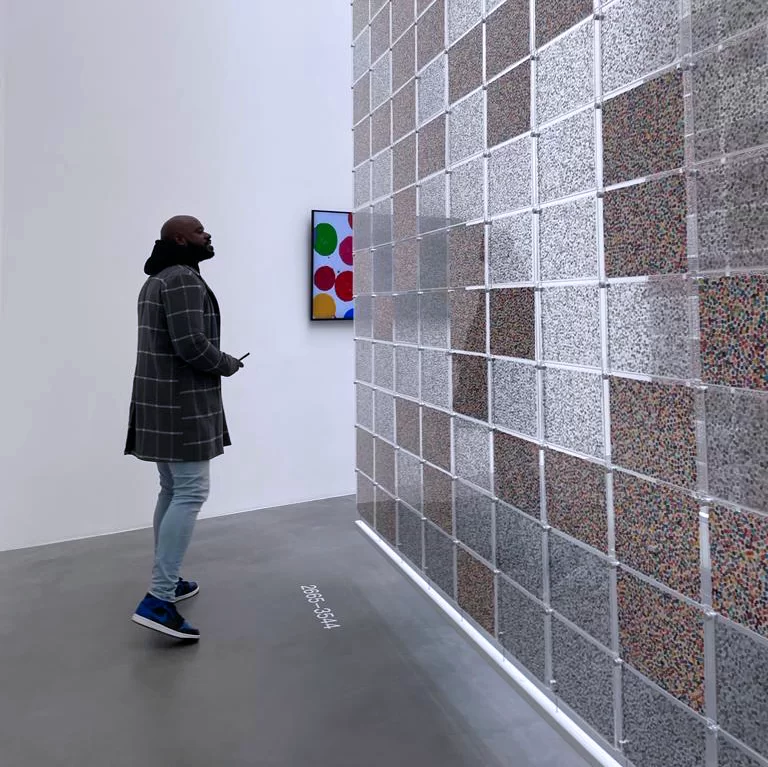Ilona Szalay paints women who seem to exist in the moment before something happens — or after it already has.
Her paintings are full of stillness that feels tense, like breath held too long. Figures — almost always female — stand mid-pose, mid-thought, caught between power and vulnerability. Their bodies suggest control but also surrender. The performance of femaleness, Szalay says, is never just one thing. And with every bold stroke, she paints not what the eye sees, rather what the soul reflects in colour — Szalay’s signature interplay of control and spontaneity that breeds intriguing results.

Courtesy of artist
I often see my paintings as fragments of a bigger narrative, glimpses into a story which will never be fully told or understood. The idea of storytelling is crucial to my practice
Ilona Szalay
Born in Beirut and based in London, Szalay works primarily in oil on glass and aluminium. The oil on glass creates a surface that feels unstable, as though the image might wash away. The surfaces stay slick, the paint appearing wet long after it dries. The images feel both delicate and exposed, as if they might dissolve under too much light. Transparency is part of the point. “There’s nowhere to hide,” she says.
Szalay studied English Literature at Oxford, and traces of literary structure run through her work. William Blake remains a touchstone — not for his mysticism, but for how he fused image and text to build entire worlds. Like Blake, Szalay tells stories in fragments. Each painting feels like a glimpse of a larger narrative that will never truly find resolve.
This week, Szalay’s poetic portrayals have continued to garner attention, with the artist winning the inaugural Women in Art Fair Prize, sponsored by Fladgate. Her references pull from mythology, classical sculpture, and colonial history. In Captive and Winged Sphinx, familiar symbols are destabilised: a nude figure bound to her pedestal; a creature with wings that can no longer fly.
The gestures are simple; the weight they carry is not. Even as her work moves across international exhibitions, Szalay returns to the same central tension: the body as both subject and object. Beautiful, vulnerable and exposed. Always performing, never fully still.
At a time when images of women are endlessly produced, Szalay’s work slows the frame, inviting something closer to contemplation — or complicity.
Your academic background in English Literature from Oxford clearly influences your work.
How do literary narratives, particularly those of William Blake, shape the visual storytelling
in your art?
Ilona Szalay: I often see my paintings as fragments of a bigger narrative, glimpses into a story which will never be fully told or understood. The idea of storytelling is crucial to my practice as I have always been profoundly stimulated and reassured by stories. The work of Willian Blake attracts me as there is a seamless symbiosis between word and image which is rare, more specifically that he manages to build an extraordinary world through both – each having its contributing qualities and both doing something the other cannot.

Much of your work explores the intersection of dominance and submission, especially through the female form. What compels you to return to these themes, and how do they evolve with each series?
Ilona Szalay: For me the female form is limitlessly paradoxical as an emblem in the arts. Representing both the seat of all creativity and life, the ultimate engine if you like, and a passive vessel to be manipulated and admired. It brings opposing and conflicting ideas together in a way that is endlessly fascinating to me as an artist. There is mystery (not just represented but in reality) to the mechanisms of the female body. It is simultaneously a sealed sacred object and a bloody orifice, a taboo which is fetishised in a million different ways.
Your figures often seem both powerful and immobilised—simultaneously statuesque and vulnerable. What does this duality suggest about the societal roles women are cast into, and how do you hope audiences interpret this tension?
Ilona Szalay: Yes, the female figures in my work are often still to the point of paralysis. Frozen in the performance perhaps. And it is this that I allude to again and again in my paintings – the performance of femaleness.
This is not to say the performance is always one thing, it takes countless forms, and it is these layers of doing/being which I enjoy exploring through my representation of the female. The power of the performance is irrefutable however transitory it may be, and it is in some ways shallow and fleeting, but there can be no doubt that as a collective we collude in and relish it. My hope is that the audience recognises this ‘doubling’, the push and pull between watching self and inhabiting self, of being simultaneously inside and outside.

In works such as Captive and Winged Sphinx, there’s an evocative use of myth and symbolism. How do these references function in your commentary on contemporary issues such as colonial legacies and systemic injustice?
Ilona Szalay: The shadow of colonialism affects so many aspects of our lives in a very real way. Living in 2025 it is not possible to be blind to this reality. I allude to the tropes of Classical mythology and patriarchal value systems in these two works by animating two immediately recognisable emblems – the nude female statue and the winged sphinx. I place them both
in vulnerable positions, the first lashed helplessly to her plinth an explosion inches from her face, and the second in a state of ramshackled decay, winged perhaps but forever grounded as the wings no longer fly. Through these simple visual subversions I intend to engage with the darker reverberations of colonialism.
You’ve described your visual language as ‘poetic and restrained’. How does your choice of material—oil on aluminium, glass, LED light—aOect the emotional tone and thematic weight of your pieces?
Ilona Szalay: I love the way oil paint behaves on slick surfaces such as glass and aluminium. It creates a perpetually ‘wet’ effect as even after it has dried it remains very much liquid as if at any moment it could be wiped away or slide off. There is something about the delicacy of this sort of mark making that I adore – it showcases the voluptuousness of liquid whilst never allowing us to forget its impermanence. I find the paint itself does much of the work and through these minimal marks I can create an almost 3D or sculptural object/image. The transparency of glass and the reflectiveness of aluminium contribute to this layered affect, we can see through the image. There is nowhere to hide, no backstage, like an x-ray all is visible right down to the bones.

Your use of cages, looping brushstrokes and static poses creates a haunting, almost silent atmosphere. How do you approach the balance between visual beauty and emotional discomfort in your compositions?
Ilona Szalay: I am certainly drawn to beauty, sometimes in a way which is detrimental (perhaps) to the overall piece. By which I mean I have a tendency to ‘prettify’ as I work, a sort of reflex towards ‘tidying up’ the image. Something I have learnt to push against, how successfully I don’t know. But the overall aesthetic remains. It is mostly about line, a sort of line that I cannot relinquish, that I return to again and again.
I love the idea of silence in my work. Silent tableaux and stasis, the bliss of silence. The solo show I did in 2023 was titled ‘We were the first that ever burst into that silent sea’ which is a quote from Coleridge’s ‘The Rhyme of the Ancient Mariner’. In that series of work I set out to create a soundless light-filled world, a genuinely strange or surreal place, surreal in its expansiveness and vibrating with light rather than noise. The emotional tone of these works was a powerful yet soft hum felt through the body, sensed more than thought of.
From London to southern Italy, your studio locations are geographically and culturally distinct. How does a sense of place—urban versus pastoral, northern versus southern—influence the emotional tenor of your work?
Ilona Szalay: It’s funny but a ‘sense of place’ has never explicitly influenced my work. I wonder what that says about my insularity and rigidity! Space matters the most, namely how much space I have to work in. In Italy I had the luxury of vast spaces in which to work which felt like a delicious unfurling – I could make works on the scale I wished (BIG) and I could step back from them far enough to see. The urban environment requires more ingenuity, it is more contracted, harder perhaps to take a broad view. I feel closer to my work, quite literally its presence is more keenly felt, and its demands feel more intense.
Figures in your work often seem paused mid-thought or mid-suOering. Do you view your subjects as portraits of specific individuals, symbolic archetypes, or something in between?
Ilona Szalay: Mid-thought, mid-suffering and I would add to that mid-posturing and mid-pleasuring! The subjects of my work are certainly not specific individuals in the conventional portraiture sense. I tend to start with a scenario or feeling and then fit the subject into that. The individual does not exist before the picture is made, the act of painting creates the subject so in that sense s/he is symbolic or emblematic, even functional. The excitement for me as an artist is creating the subject as the painting evolves.

Your paintings often seem to ‘speak’ through posture and gesture rather than expression. How do you choreograph these silent conversations, and what do you hope viewers take away from them?
Ilona Szalay: The masklike quality or blankness of many of the faces in my work allows me to present images with more ambiguity. The human face is a mask in so far as we are conditioned to express emotions and thoughts in certain socially acceptable ways. The smile, for example, is associated with pleasure and happiness however can often more closely resemble a snarl or a defensive grid (of bared teeth!).
I like to do away with this language of faces in my work. The body is more interesting to me, more honest perhaps than the face, certainly more complex and varied. Its language has a more wide ranging vocabulary and is more compelling to me. It is my hope that the ‘silent conversations’ of the body bypass some of the reflexive moral and cultural conventions which we have internalised around visual codes and cues.
You’ve received recognition with awards and international exhibitions. Has that visibility altered your sense of creative freedom or responsibility as an artist engaging with themes of injustice and inequality?
Ilona Szalay: Any recognition I have received as an artist has allowed me to take my own practice more seriously. It has allowed me to engage more fully with areas of interest and to go deeper and with greater confidence into themes which perhaps I felt I had little ‘right’ to explore. In this way visibility has made me feel more alive to exploration. Regarding responsibility, yes, as I reach a wider audience I have a keener sense of wanting to bring work of the highest calibre I can muster, whether the themes are inequality or anything else
Looking ahead, are there themes or media you’ve yet to explore that you feel drawn to? What challenges or questions are currently shaping your studio practice?
Ilona Szalay: I would love to experiment with printmaking as I think some of my work would lend itself well to that medium as so much of it is linear. I would also like to scale up my work on glass with the idea that the works would be exhibited free-standing allowing light to be a component, as intended. Challenges and questions are always essentially the same : How do I realise in the exterior world what I can imagine in my mind? And is my contribution valid? These in all their various forms!
©2025 Ilona Szalay





